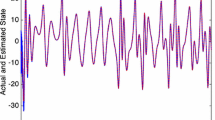Abstract
In this paper, an online identification method is proposed for nonlinear system identification based on extreme learning machine (ELM)–Hammerstein model. The ELM–Hammerstein model comprises an ELM neural network followed by a linear dynamic subsystem. This model is linear in parameters and nonlinear in the input. To speed up the convergence and meanwhile improve identification accuracy, a changing forgetting factor recursive least squares (CFF-RLS) method is proposed as online learning algorithm. The algorithm can identify the parameters of linear dynamic subsystem and the weights of ELM neural network simultaneously. Simulation results verify the effectiveness of the proposed method.



















Similar content being viewed by others
References
Abonyi J, Babuška R, Botto MA, Szeifert F, Nagy L (2000) Identification and control of nonlinear systems using fuzzy Hammerstein models. Ind Eng Chem Res 39(11):4302–4314
Bai EW (2004) Decoupling the linear and nonlinear parts in Hammerstein model identification. Automatica 40(4):671–676
Bai EW, Fu M (2002) A blind approach to Hammerstein model identification. IEEE Trans Signal Process 50(7):1610–1619
Cervantes AL, Agamennoni OE, Figueroa JL (2003) A nonlinear model predictive control system based on Wiener piecewise linear models. J Process Control 13(7):655–666
Chaudhary NI, Raja MAZ, Khan JA, Aslam MS (2013) Identification of input nonlinear control autoregressive systems using fractional signal processing approach. Sci World J 2013:13, Art ID 467276. doi:10.1155/2013/467276
Farmer JD (1982) Chaotic attractors of an infinite-dimensional dynamical system. Phys D Nonlinear Phenom 4(3):366–393
Fink A, Nelles O (2001) Nonlinear internal model control based on local linear neural networks. In: IEEE international conference on systems, man, and cybernetics, pp 117–122
Giri F, Chaoui FZ, Rochdi Y (2011) Parameter identification of a class of Hammerstein plants. Automatica 37(5):749–756
Greblicki W, Pawlak M (1991) Nonparametric identification of a cascade nonlinear time series system. Signal Process 22(1):61–75
Hong X, Chen S (2012) The system identification and control of Hammerstein system using non-uniform rational B-spline neural network and particle swarm optimization. Neurocomputing 82:216–223
Huang GB (2015) What are extreme learning machines? Filling the gap between frank rosenblatt’s dream and john von neumann’s puzzle. Cognit Comput 7:263–278
Huang G, Huang GB, Song S, You K (2015) Trends in extreme learning machines: a review. Neural Netw 61:32–48
Huang GB, Zhou H, Ding X, Zhang R (2012) Extreme learning machine for regression and multiclass classification. IEEE Trans Syst Man Cybern Part B Cybern 42(2):513–529
Huang GB, Zhu Q, Siew CK (2004) Extreme learning machine: a new learning scheme of feedforward neural networks. In: Neural networks, 2004. Proceedings. 2004 IEEE international joint conference on, vol 2, pp 985–990
Jia L, Chiu MS, Ge SS (2005) A noniterative neuro-fuzzy based identification method for Hammerstein processes. J Process Control 15(7):749–761
Juang CF, Huang RB, Lin YY (2009) A recurrent self-evolving intervatl type-2 fuzzy neural network for dynamic system processing. IEEE Trans Fuzzy Syst 17(5):1092–1105
Krzyźak A (1996) On nonparametric estimation of nonlinear dynamic systems by the Fourier series estimate. Signal Process 52(3):299–321
Le F, Markovsky I, Freeman CT, Rogers E (2012) Recursive identification of Hammerstein systems with application to electrically stimulated muscle. Control Eng Pract 20(4):386–396
Leung SH, So CF (2005) Gradient-based variable forgetting factor RLS algorithm in time-varying environments. IEEE Trans Signal Process 53(8):3141–3150
Li CH, Zhu XJ, Cao GY, Sui S, Hu MR (2008) Identification of the Hammerstein model of a PEMFC stack based on least squares support vector machines. J Power Sour 175(1):303–316
Liang NY, Huang GB, Saratchandran P, Sundararajan N (2006) A fast and accurate online sequential learning algorithm for feedforward networks. IEEE Trans Neural Netw 17(6):1411–1423
Mirri D, luculano G, Filicori F, Pasini G, Vannini G, Gabriella G (2002) A modified Volterra series approach for nonlinear dynamic systems modeling. IEEE Trans Circ Syst Fund Theor Appl 49(8):1118–1128
Narendra KS, Gallman P (1966) An iterative method for the identification of nonlinear systems using a Hammerstein model. IEEE Trans Autom Control 11(3):546–550
Narendra KS, Parthasarathy K (1990) Identification and control of dynamical systems using neural networks. IEEE Trans Neural Netw 1(1):4–27
Paleologu C, Benesty J, Ciochina S (2008) A robust variable forgetting factor recursive least-squares algorithm for system identification. Signal Process Lett IEEE 15:597–600
Park D, Jun B, Kim J (1991) Fast tracking RLS algorithm using novel variable forgetting factor with unity zone. Electron Lett 27(1):2150–2151
Pawlak M (1991) On the series expansion approach to the identification of Hammerstein systems. IEEE Trans Autom Control 36(6):763–767
Salimifard M, Jafari M, Dehghani M (2012) Identification of nonlinear MIMO block-oriented systems with moving average noises using gradient based and least squares based iterative algorithms. Neurocomputing 94:22–31
Shi J, Xu X, Dai Y (2011) Identification of Hammerstein LSSVM-ARMA systems and its application in continuous stirred tank rector. Energy Proced 13:5359–5365
Song S, Lim JS, Baek S, Sung KM (2000) Gauss Newton variable forgetting factor recursive least squares for time varying parameter tracking. Electron Lett 36(11):988–990
Tang Y, Li Z, Guan X (2014) Identification of nonlinear system using extreme learning machine based Hammerstein model. Commun Nonlinear Sci Numer Simul 19(9):3171–3183
Tanomaru J, Omatu S (1992) Process control by on-line trained neural controllers. IEEE Trans Ind Electron 39(6):511–521
Togun N, Baysec S, Kara T (2012) Nonlinear modeling and identification of a spark ignition engine torque. Mech Syst Signal Process 26:294–304
Wang JS, Hsu YL (2010) An MDL-based Hammerstein recurrent neural network for control applications. Neurocomputing 74(1–3):315–327
Wang Y, Cao F, Yuan Y (2011) A study on effectiveness of extreme learning machine. Neurocomputing 74(16):2483–2490
Wigren T, Nordsjo AE (1999) Compensation of the RLS algorithm for output nonlinearities. IEEE Trans Autom Control 44(10):1913–1918
Zhang J, Wang Q (2009) Hammerstein model identification of continuous stirred tank reactor based on least squares support vector machines. In: Control and decision conference, pp 2858–2862
Acknowledgments
This work is supported by the National Natural Science Foundation of China (Nos. 61273260, 61471313), Natural Science Foundation of Hebei Province (No. F2014203208), the Specialized Research Fund for the Doctoral Program of Higher Education of China (No. 20121333120010), China Postdoctoral Science Foundation (Nos. 2013M530888, 2014T70229).
Author information
Authors and Affiliations
Corresponding author
Rights and permissions
About this article
Cite this article
Tang, Y., Han, Z., Wang, Y. et al. A changing forgetting factor RLS for online identification of nonlinear systems based on ELM–Hammerstein model. Neural Comput & Applic 28 (Suppl 1), 813–827 (2017). https://doi.org/10.1007/s00521-016-2394-5
Received:
Accepted:
Published:
Issue Date:
DOI: https://doi.org/10.1007/s00521-016-2394-5




